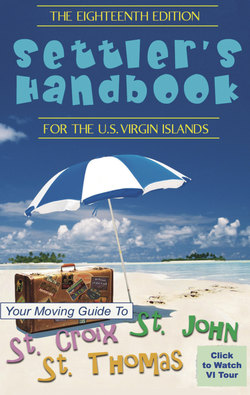Читать книгу VI Settler's Handbook - Mr. Cheyenne Harty - Страница 14
The New VI Economy
ОглавлениеThe last sugar factory on St. Croix closed in 1966. Since then, the island’s economy has been based on light and heavy industry, immigration, and tourism.St.Croix’s industrial history is dynamic, and its changing nature is evidenced in the shining steel labyrinths dotting the south shore. On the western end of St.Croix’s industrial landscape is the site of a former aluminum facility, which was first established in 1965 as Harvey Alumina. Over the years, the property has been owned by several aluminum companies, including Martin Marietta, Virgin Islands Alumina Corporation (VIALCO), and finally, Alcoa World Aluminum Corporation (ALCOA). Following a steady decline in the global aluminum market, ALCOA sold the site to St. Croix Renaissance Group, which has transformed the former aluminum plant into an industrial park. Renaissance Group touts the location’s deep ports, desalinization plant and coal-fired power plant as amenities to attract tenants, which today includes Diageo, makers of Captain Morgan’s rum.
West of the Renaissance park is the site of the now shuttered HOVENSA, the company that has had the most impact on the island’s recent economic history. Hess Oil Refinery of the Virgin Islands (HOVIC) began operations in 1966 and gradually increased its production to 650,000, making it the largest oil refinery in the world until 1974. In 1998 Hess Oil entered into a partial merger with Venezuelan oil company Petroleos de Venezuela and is now called HOVENSA. In January 2012, citing hemorrhaging finances, a weak global economy, and anemic projections for the refinery industry, HOVENSA announced intentions to pull the plug on its refinery operations, a move that led to layoffs for most of the company’s approximately 2,000 employees. As of press time, the closure continues to have ripple effects on the local economy and has led to contention between the VI Government and HOVENSA over how to move forward. HOVENSA expressed an interest in continuing on as an oil storage facility. The government wanted the facility either reopened as a refinery, or sold and operated as such. The VI Legislature rejected one proposed buyer citing the main reason as insufficent funding. There have been lawsuits filed by each party against the other. In September 2015 HOVENSA filed for Chapter 11 bankruptcy protection. An auction was held on November 10 in which several bidders participated in vying for all or a part of HOVENSA’s assets. ArcLight Capital Partners was the winner. At press time the proposed operating agreement was scheduled to go before the VI Legislature for ratification. The new owners propose among other things to operate as an oil storage terminal and will evaluate within 18 months the feasibility of reopening as a refinery.
Historically, oil and aluminum have been a catalyst for immigration. Labor needs in the last two decades have been satisfied by heavy immigration from Puerto Rico (continuing a century-old trend), from the United States mainland, and other parts of the Caribbean. The territory’s population rebounded to 32,099 in 1960, and nearly tripled that figure by the early 1970s due mainly to new settlers and slower emigration. A 1969 study estimated that nearly a third of the territory’s population was born in the Virgin Islands. Another third was born in the United States mainland, Europe and Puerto Rico. The final third were residents, bonded, and/or illegal aliens, almost exclusively from other islands in the Caribbean. As a result of unofficial immigration, the hard figures on population breakdowns are nearly non-existent. The United States Coast Guard, and the United States Border Patrol continue to battle the illegal immigration problem.
By 1977, when the territory’s population was over 89,000, the portion of non-citizens had declined to less than a quarter of the population, with half of that number as permanent residents and the proportion of bonded workers or aliens dropping steadily. These figures don’t necessarily represent the real number of people moving in or out, as categories change when residents become U.S. citizens and aliens achieve permanent status or return to home islands. Some bonded “temporary” workers have been in the Virgin Islands for two decades.
In 1982, the Congress of the United States passed the Virgin Islands Non Immigrant Alien Adjustment Act in order “to eliminate the uncertainty and insecurity of aliens who: a) legally entered the Virgin Islands of the United States as non immigrants for employment under the temporary alien labor program; b) have continued to reside in the Virgin Islands for long periods and, as a result, c) have contributed to the economic, social and cultural development of the Virgin Islands and have become an integral part of the society of the Virgin Islands.”
Those who fell in this category and had lived within the territory since June 30, 1975 were given one year to comply with residency prerequisites (inspection and admission to the Virgin Islands as non-immigrant alien workers, their spouses, or their minor children). In the late 1980s many illegal aliens who had complied with the earlier requirements were granted permanent status under a United States Immigration Service Amnesty program. This new status often brought access to healthcare, education, housing, and the opportunity to eventually apply for citizenship.
On St. Croix possibly 45% of the population is Spanish speaking, traditionally of Puerto Rican descent and more recently, arrivals from the Dominican Republic.
St. Thomas has two French communities from St. Barths and Haiti. Settlers to the Virgin Islands have come from the British Virgin Islands, Denmark, Germany, Spain, Portugal, India, Philippines, the Lesser and Greater Antilles, the Caribbean in general, the Arab nations, and the Far East. The United States Virgin Islands is a mini-United Nations where the “melting pot” bubbles to quelbe, soca, reggae, country, zouk and mainstream top 40 beats.
